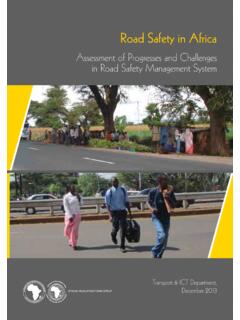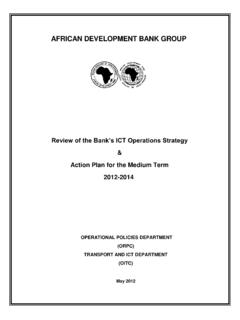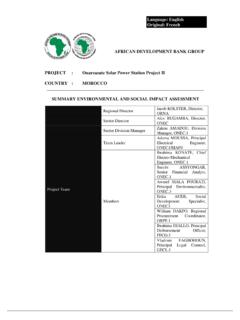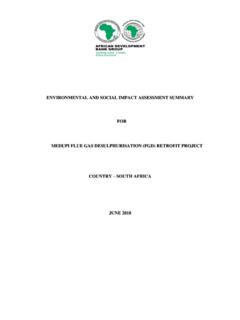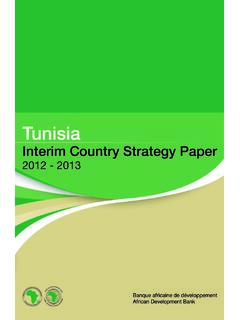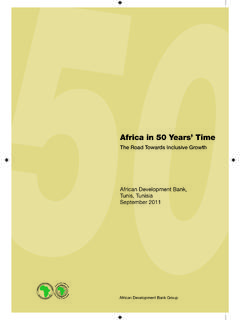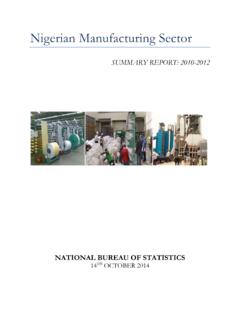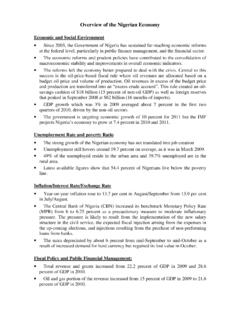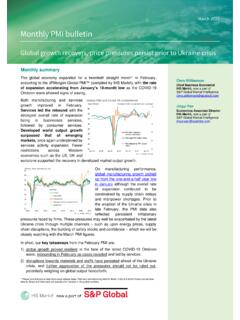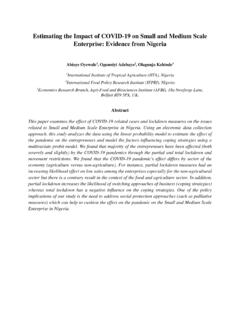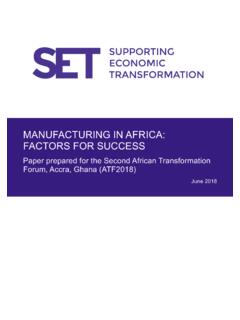Transcription of Africa’s Automotive Industry: Potential and Challenges
1 African Development Bank GroupAfrica s Automotive Industry: Potential and ChallengesWorking Paper SeriesAnthony Black, Brian Makundi and Thomas McLennanIndustrialise African 282 September 20173 Working Paper No 282 Abstract The low level of industrialisation is a major problem in Africa. Many analysts have argued that lack of structural change during the phase of economic expansion since 2000 will impede future growth prospects due to the ongoing reliance on commodities. This in turn has serious consequences for the ability to expand employment. This paper outlines the limitations of industrial development in Africa in recent decades and briefly explores the various industrialisation options. It then goes on to use the example of the Automotive industry to examine both the possibilities and pitfalls facing the development of this important sector .
2 The Automotive industry is a relatively sophisticated industry, but with sub-Saharan Africa s rapidly expanding market and Automotive trade deficit of $ billion, it is important that ways are found to efficiently attract investment especially into parts of the sector , which are more appropriate for lower-income countries. A number of larger countries such as Nigeria and Kenya are now embarking on plans to develop domestic Automotive production. Some of these plans run the risk of encouraging low-volume, inefficient production which provides little value added or employment. What is required is the broadening of the market through regional integration to allow for large-scale, productive investment. These issues are explored using Kenya as a case study. Rights and Permissions All rights reserved.
3 The text and data in this publication may be reproduced as long as the source is cited. Reproduction for commercial purposes is forbidden. The WPS disseminates the findings of work in progress, preliminary research results, and development experience and lessons, to encourage the exchange of ideas and innovative thinking among researchers, development practitioners, policy makers, and donors. The findings, interpretations, and conclusions expressed in the Bank s WPS are entirely those of the author(s) and do not necessarily represent the view of the African Development Bank Group, its Board of Directors, or the countries they represent. Working Papers are available online at Produced by Macroeconomics Policy, Forecasting, and Research Department Coordinator Adeleke O. Salami This paper is the product of the Vice-Presidency for Economic Governance and Knowledge Management.
4 It is part of a larger effort by the African Development Bank to promote knowledge and learning, share ideas, provide open access to its research, and make a contribution to development policy. The papers featured in the Working Paper Series (WPS) are those considered to have a bearing on the mission of AfDB, its strategic objectives of Inclusive and Green Growth, and its High-5 priority areas to Power Africa, Feed Africa, Industrialize Africa, Integrate Africa and Improve Living Conditions of Africans. The authors may be contacted at Correct citation: Black, A., Makundi, B. and McLennan T. (2017), Africa s Automotive Industry: Potential and Challenges , Working Paper Series N 282, African Development Bank, Abidjan, C te d Ivoire. 1 Africa s Automotive Industry: Potential and Challenges Anthony Black, Brian Makundi, and Thomas McLennan1 JEL: F15, L52, L62, O25 Keywords: Industrialisation, Africa, regional integration, Automotive industry 1 Policy Research in International Services and manufacturing , and School of Economics, University of Cape Town (all authors).
5 2 1. Introduction Notwithstanding the recent trough in the commodity cycle, African growth rates since 2000 have been impressive, and in some cases even spectacular. It is, however, a striking fact that manufacturing has not kept pace. The level of industrialisation remains low, and manufacturing has declined as a share of GDP. Examples of dynamic manufacturing growth are few and far between. Limited industrialisation is Africa s Achilles heel. There are very few instances where manufacturing growth has been the engine of rapid development in the continent. There are a number of reasons for this. One important factor is simply the reliance on commodities: Africa, according to Wood and Mayer (2001), has a comparative advantage in land, resources, and resource-based products. But Wood and Mayer go further to show that, even as a region that is well endowed in resources, Africa underperforms in manufacturing .
6 There have also been inappropriate policies, which have led to inefficient industrialisation in a number of countries. For example, the style of import substitution industrialisation led to problems in the early years of independence. Much of this was then swept away by the combination of economic crisis and draconian liberalisation under structural adjustment . With rapid growth on the continent since the turn of the century, conditions have become more conducive to manufacturing development and the question is whether a more deeply rooted process of industrialisation is starting to emerge. To address these questions we consider the case of a sector that is important both in terms of its overall size, and its linkages to a wide range of manufacturing activities the Automotive industry.
7 The market for cars and commercial vehicles is growing rapidly but for the most part is supplied by imports of used vehicles. A number of countries are putting plans in place to expand production. Kenya, as the most industrialised country in east Africa and with a history of involvement in the Automotive industry going back to the 1970s, is used as a case study. Section 2 outlines the experience of industrialisation in Africa and the various strategic options faced by African countries. Section 3 examines the growing market for vehicles and the small-scale production emerging in some countries. In section 4 we provide an illustration of these issues using Kenya as a case study. Section 5 concludes. 3 2. Limited industrialisation in Africa Industrialisation has everywhere been associated with economic development.
8 However, in Africa the link appears weak. The share of manufacturing in GDP was around 10 percent in 2015 and, as Table 1 illustrates, the sector has grown more slowly than the economy as a whole in every period since the 1960s. This includes the low-growth crisis years of the late 20th century as well as the boom times since 2000. The United Nations Economic Commission for Africa (UNECA) refers to this as deindustrialisation (UNECA, 2015) and in a sense this is the case. However, it is important to note that manufacturing has been growing in absolute terms. Table 1: Overall and sectoral GDP growth in Africa (percentage per annum) Growth 1961-1979 1980-1999 2000-2012 GDP Agriculture Industry* manufacturing Services Source: UNECA, 2015: 47 * Industry includes mining, electricity production, etc.
9 African countries generally have underperformed compared to Asian countries with regard to manufacturing growth, manufactured exports and manufacturing as a share of GDP (Table 2). They perform particularly poorly according to the United Nations Industrial Development Organization (UNIDO) s Competitive Industrial Performance (CIP) Index, which is designed to determine long-run sustainable growth of manufacturing (UNIDO, 2015) the Index is an indicator of how countries have upgraded technological capabilities, expanded production capacity, improved infrastructure and adopted suitable policies to improve manufacturing value added over time. Kenya, which is the subject of section 4, ranks ahead of its regional peers but nevertheless performs poorly according to this indicator.
10 The background context for Africa s poor manufacturing performance is well understood. In the post-independence period, manufacturing grew quite rapidly supported by import substitution policies and other forms of state support. Given the small domestic markets and the low level of manufacturing capabilities, much of this capacity was inefficient in the 2 The CIP Index is derived by assessing countries manufacturing development and industrial competitiveness over time by looking at the capacity of countries to increase their presence in international and domestic markets while developing industrial sectors and activities with higher value added and higher technological levels (UNIDO, 2015). 4 sense of being internationally uncompetitive.
